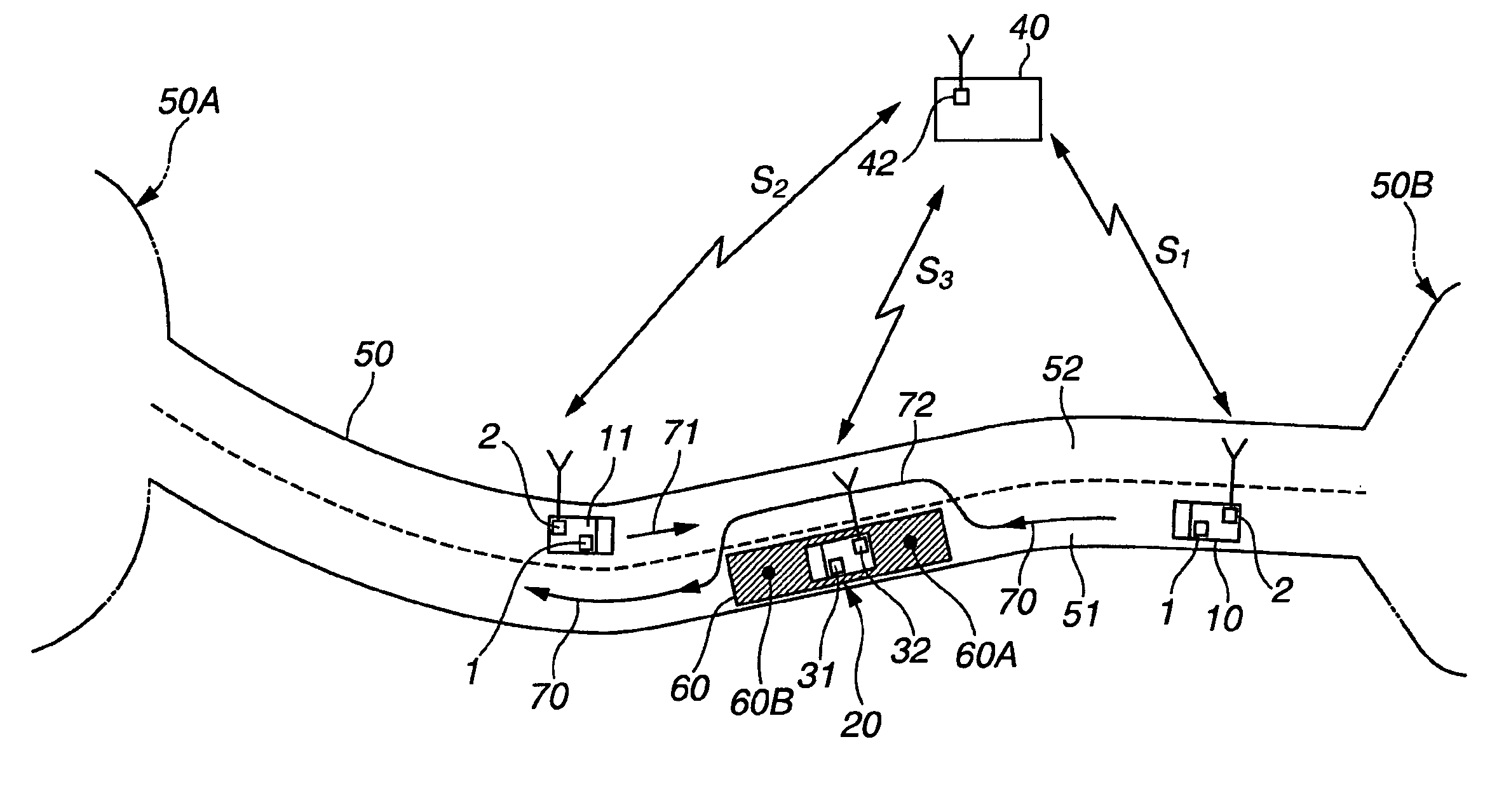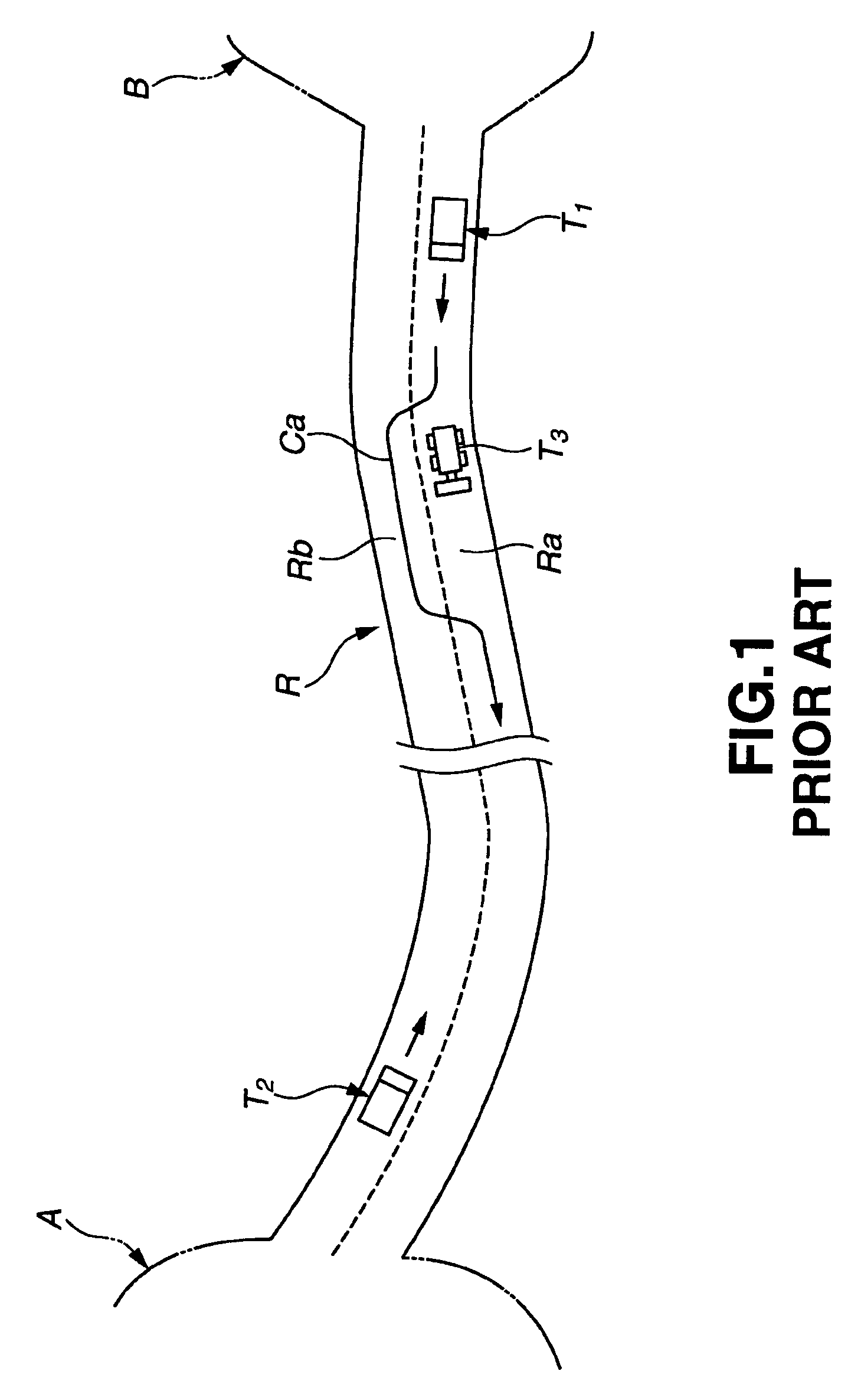Travel control device and method for vehicles
a technology for controlling devices and vehicles, applied in the direction of distance measurement, navigation instruments, instruments, etc., can solve the problems of reducing the efficiency and work efficiency of conveyancing, the inability of vehicles to continue high-speed traveling without, and the practicability of making all vehicles traveling in the work area unmanned
- Summary
- Abstract
- Description
- Claims
- Application Information
AI Technical Summary
Benefits of technology
Problems solved by technology
Method used
Image
Examples
first embodiment
Detouring when a Manned Vehicle is Carrying Out a Work
[0078]Hereinafter, a procedure of a process in the embodiment is described with reference to FIGS. 4A, 4B, 4C, 4D showing the traveling path 50, and the flowchart shown in FIG. 5.
[0079]This embodiment assumes the case in which the manned vehicle 20 carries out a road construction or the like on the traveling road 50.
[0080]First of all, before starting the work on a mine, map data of the traveling road 50 is inputted from the input device 46 of the monitor station 40 and stored in the operation data sharing device 43. This map data includes data showing the terrain of a position of a shoulder of the traveling road 50 or other terrain. The map data of the traveling road 50 is transmitted to all of the unmanned vehicles 10, 11 via the communication device 42 of the monitor station 40 by means of the wireless communications S1, S2 received by the communication device 2 of each of the unmanned vehicles 10, 11 and stored in the operati...
second embodiment
Detouring when a Manned Vehicle is Traveling at Low Speed
[0125]Hereinafter, a procedure of a process in the embodiment is described with reference the configuration diagrams of FIGS. 6A, 6B, 6C, FIGS. 7A, 7B, 7C, 7D showing the traveling path 50, and the flowcharts shown in FIGS. 8 and 9.
[0126]Each of FIGS. 6A, 6B, 6C corresponds to each of FIGS. 3A, 3B, 3C and the reference numerals in FIG. 6 indicate the same components, thus the explanations thereof are omitted accordingly.
[0127]However, as shown in FIG. 6A, the manned vehicle 20 is provided with a passing controller 35′ instead of the restricted area controller 35.
[0128]Moreover, the monitor station 40 is not provided with the input device 46 or display device 47 shown in FIG. 3B, but is provided with the passing controller 45′ instead of the restricted area controller 45.
[0129]The configurations of the unmanned vehicles 10, 11 are same as those shown in FIG. 3C.
[0130]This embodiment assumes a case in which the manned vehicle 20...
third embodiment
Detouring when an Unmanned Vehicle is Traveling at Low Speed
[0177]Hereinafter, a procedure of a process in the embodiment is described with reference the configuration diagrams of FIGS. 10A, 10B, 10C and FIGS. 11A, 11B, 11C showing the traveling path 50.
[0178]In this embodiment, the manned vehicle 20 traveling at low speed in the second embodiment is replaced with an unmanned vehicle 12 traveling at low speed, thus the explanations which overlap with those of the second embodiment are omitted.
[0179]FIGS. 10 A, 10B, 10C correspond to FIGS. 6A, 6B, 6C. The reference numerals in FIGS. 6A, 6B, 6C indicate the same components, thus the explanations thereof are omitted accordingly.
[0180]The configurations of the unmanned vehicles 10, 11 are same as the configuration shown in FIG. 6C of the second embodiment, as shown in FIG. 10C.
[0181]The configuration of the slow unmanned vehicle 12 to be passed is same as the configurations of other unmanned vehicles 10, 11 (FIG. 10C), as shown in FIG. ...
PUM
 Login to View More
Login to View More Abstract
Description
Claims
Application Information
 Login to View More
Login to View More - R&D
- Intellectual Property
- Life Sciences
- Materials
- Tech Scout
- Unparalleled Data Quality
- Higher Quality Content
- 60% Fewer Hallucinations
Browse by: Latest US Patents, China's latest patents, Technical Efficacy Thesaurus, Application Domain, Technology Topic, Popular Technical Reports.
© 2025 PatSnap. All rights reserved.Legal|Privacy policy|Modern Slavery Act Transparency Statement|Sitemap|About US| Contact US: help@patsnap.com



